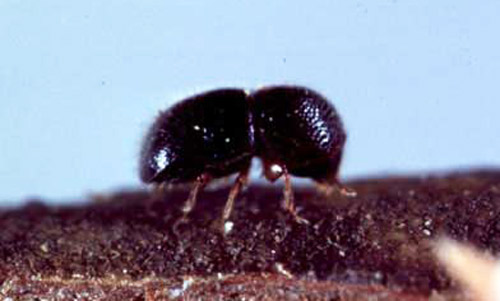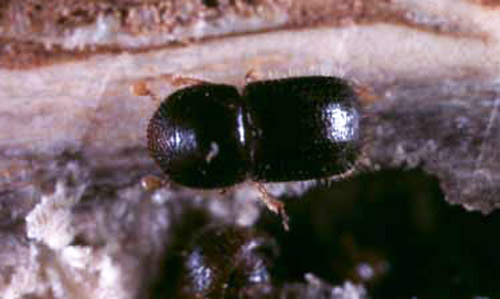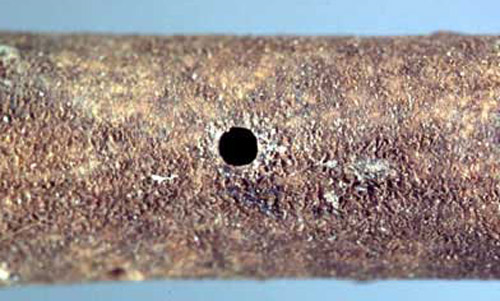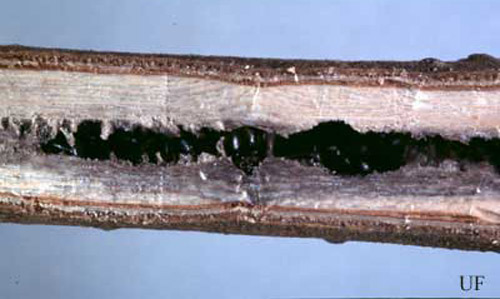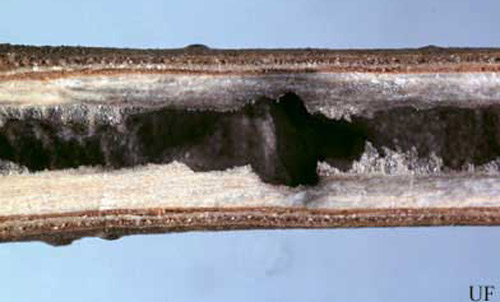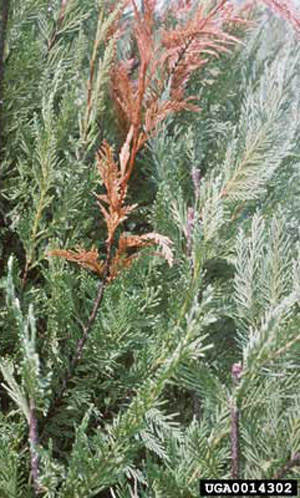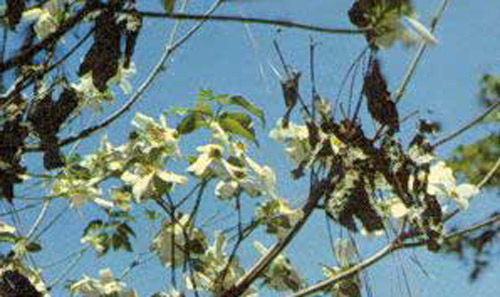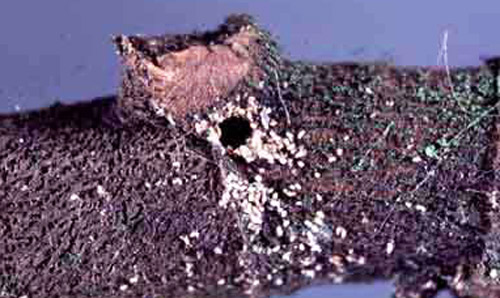common name: black twig borer
scientific name: Xylosandrus compactus (Eichhoff) (Insecta: Coleoptera: Curculionidae: Scolytinae)
Introduction - Taxonomy - Distribution - Description - Diagnosis - Biology - Hosts - Survey and Detection - Management - Selected References
Introduction (Back to Top)
The black twig borer, Xylosandrus compactus (Eichhoff), is one of the few ambrosia beetles that infests healthy plants. In Florida, orchids (Dendrobium spp. and Cattleya spp.), and avocado (Persea americana Mill.) have sustained notable economic losses (Dekle and Kuitert 1968, McClanahan 1951). Although ornamental shrubs and shade trees seldom die from beetle infestations, the loss of growth and aesthetics can be substantial. Elsewhere, the black twig borer is a serious pest of coffee, Coffea canephora Pierre (esp. var. robusta Ineac) (Brader 1964).
Figure 1. Adult female black twig borer, Xylosandrus compactus (Eichhoff), in southern magnolia twig. This side view shows the head concealed in the pronotum and the gently rounded declivity. Females are 1.4-1.9 mm in length and males (not shown) are 0.8-1.1 mm. Males do not fly and are rarely found outside the brood chamber. Photograph by Lyle J. Buss, University of Florida.
Taxonomy (Back to Top)
This species was generally identified as Xyleborus morstatti Hagedorn until 1962 when Murayama and Kalshoven recognized the precedence of Eichhoff's 1875 description of Xyleborus compactus. At about the same time, Brown (1963) resurrected the genus Xylosandrus Reitter (1913) from its long-time synonymy with Xyleborus, Xylosandrus being distinguished by having the anterior coxae widely separated rather than contiguous or narrowly separated. Bright (1968) and Wood (1982) also recognized Xylosandrus as a distinct genus with about 25 species worldwide and 4 species occurring in the eastern United States.
Distribution (Back to Top)
The black twig borer was first collected in the United States at Ft Lauderdale, Florida in 1941 (Wood 1982). By the mid 1970s, its range extended northward to Tallahassee and Savannah, Georgia (Ngoan et al. 1976). The present distribution in the Southeast is along the Coastal Plain from Texas to North Carolina. This beetle is also present in Hawaii. Its pantropical distribution includes Brazil, Cuba, Indonesia, Japan, and Sri Lanka (Ceylon) (Bright 1968, Murayama and Kalshoven 1962, Wood 1982).
Description (Back to Top)
Adult female length 1.4 to 1.9 mm, width 0.7 to 0.8 mm; body stout, cylindrical, elongate, brown to black; distinct punctures on pronotum posterior; transversely oriented hair tuft at base of pronotum; and long strial setae. Adult male length 0.8 to 1.1 mm, width 0.4 to 0.5 mm; body rounded, dwarfed, reddish-brown; all characters poorly formed; flightless and rare. Egg small (0.3 mm wide x 0.5 mm long), white, and ovoid. Mature larva length ca. 2 mm; head capsule pale brown; body creamy white and legless. Pupa length similar to adult; body creamy white; form exarate.
Figure 2. Dorsal view of adult female black twig borer, Xylosandrus compactus (Eichhoff), with her brood in a chamber. The white fungus growing on the chamber wall is food for the larvae and adults. Photograph by Lyle J. Buss, University of Florida.
Diagnosis (Back to Top)
Table 1 summarizes various morphological and biological characteristics that can be used to distinguish the four Xylosandrus species established in the eastern United States. The first two species are frequent pests of many woody plants throughout Florida. They are readily distinguished with the aid of a microscope by noting that compactus is less than 2 mm long and has a shiny declivity, whereas crassiusculus is more than 2 mm long and the declivity appears dull and bumpy.
These two species can also be distinguished based on the location of their galleries. X. compactus, the black twig borer, attacks twigs less than 2 cm diameter, whereas crassiusculus infests larger twigs, branches and stems 2 to 8 cm in diameter. The third species, germanus, has not yet extended its range into northern Florida although it does occur as close as central Georgia and Alabama. It, like crassiusculus, is longer than 2 mm, but has a shiny rather than dull declivity. Also, it is the species most likely to be found infesting healthy, large-diameter material. The fourth species, zimmermanni, is found only in South Florida where it breeds only in severely stressed and recently cut branches 1 to 3 cm in diameter. Small like compactus, it requires careful examination to note the longitudinal orientation of the small tuft of hair on the pronotum.
| Character | X. compactus | X. crassiusculus | X. germanus | X. zimmermanni |
| Female size | 1.4-1.9 mm | 2.1-2.9 mm | 2.0-2.4 mm | 1.3-1.5 mm |
| Surface of declivity |
Shining and smooth |
Dull and granulate |
Shining | Shining |
| Hair tuft on base of pronotum |
Forms transverse row |
-- | -- | Tuft oriented longitudinally |
| Geographic location | Throughout Florida and from North Carolina to eastern Texas. |
Throughout Florida and from North Carolina to eastern Texas. |
From Connecticut to Missouri, east Texas, and central Georgia. Might appear in North Florida |
Subtropical South Florida and Mexico to Venezuela. |
| Common host material |
In small twigs on healthy, cut and stressed plants. |
In wood of large twigs, small branches and stems. |
In wood of large twigs, small branches and stems. |
Only in unhealthy, cut, or broken branches 1-3 cm diameter |
Biology (Back to Top)
Only adult females initiate infestation of host plants. Male beetles are flightless, remain solely in brood galleries, and arise from parthenogenesis (production of male progeny without fertilization), thus haploid in genetic composition. In a host twig or branch the female constructs an entrance tunnel into the pith or wood to a depth of 1 to 3 cm where a small cavity is formed and a loose cluster of eggs is deposited. One or more females may occupy a twig or branch. Generally, there is only a single female if twig diameter is less than 7 mm, but up to 20 females for branch diameters from 8 to 22 mm. Larvae feed on a mixture of ambrosial fungus (Fusarium solani (Mart.) Sacc.) cultured on chamber walls and host plant tissues. Pupation and mating of brood adults occurs in the infested material. The brood adults emerge through the entrance holes of the parent beetles, which are located on branch undersides. Approximately 28 days (at 25ºC) are required for development from egg to adult. In north central Florida, adults overwintering in Cornus florida emerge during late February, attack twigs in March, and brood production begins in April. Highest population levels occur from June to September. Adults overwinter in damaged twigs and branches (Ngoan et al. 1976, Wood 1982).
Figure 3. Entrance hole, with bark removed, of the black twig borer, Xylosandrus compactus (Eichhoff). Small attack-emergence holes, 0.7 to 0.9 mm in diameter, associated with brood chambers in the pith of a dead twig are signs of black twig borer infestation. Photograph by Lyle J. Buss, University of Florida.
Figure 4. Infested twig with brood of the black twig borer, Xylosandrus compactus (Eichhoff), ready to emerge. As many as 40 beetles may develop in a single chamber although 10 to 15 is the typical number. Photograph by Lyle J. Buss, University of Florida.
Figure 5. Empty brood chamber of the black twig borer, Xylosandrus compactus (Eichhoff). Brood chambers range from 2 to 57 mm in length. Photograph by Lyle J. Buss, University of Florida.
Hosts (Back to Top)
Over 224 plant species, belonging to 62 families, are susceptible to black twig borer infestation (Ngoan et al. 1976). Known hosts in Florida include:
- Acer barbatum Michx., A. negundo L. , A. rubrum L.,
- Callicarpa americana L., Carya illinoensis (Wang.) K. Koch, C. glabra (Mill.) Sweet, Cassia fistula L., Cattleya skinneri Lindl., Celtis laevigata Willd., Cercis canadensis L., Cinnamomum camphora (L.) Nees and Eberm., Cornus florida L.,
- Dendrobium pulchellum Roxb.,
- Khaya nyasica Stapbf., Koelreuteria elegans (Seem.) A.C. Sm.,
- Liquidamber styraciflua L.,
- Macadamia ternifolia F.V. Muell., Magnolia grandiflora L., Malus pumila Mill., Mangifera indica L.,
- Ostrya virginiana (Mill.) K. Koch,
- Persea americana Mill., P. borbonia (L.) Spreng., Platanus occidentalis L.,
- Quercus laurifolia Michx., Q. nigra L.,
- Salix sp., Sambucus simpsonii Rehder, and Symploscos tinctoria (L.) L'Her.
Figure 6. Leyland cypress infested by the black twig borer, Xylosandrus compactus (Eichhoff). Photograph by Andrew J. Boone, South Carolina Forestry Commission, www.forestryimages.com.
Survey and Detection (Back to Top)
Wilting of twigs and branches usually becomes evident within weeks after beetle infestation. Entrance holes are small (0.8 mm wide) and are located on the underside of branches. Cankers 10 to 210 mm long are common around the attacked area of larger twigs and branches. Flowering dogwood (C. florida), redbud (C. canadensis), and red maple (A. rubrum) are common hosts and may serve useful as monitor plants for timing of control measures. A whitish-exudate is common in avocado twig infestations.
Figure 7. Wilted branch infested by the black twig borer, Xylosandrus compactus (Eichhoff). On some hosts, like dogwood shown here, the leaves begin to curl and wilt about one week after infestation and turn brown in two weeks. Photograph by FDACS - Division of Forestry.
Figure 8. Entrance hole of the black twig borer, Xylosandrus compactus (Eichhoff), into magnolia twig. The frass around the hole indicates a new infestation. Photograph by Lyle J. Buss, University of Florida.
Management (Back to Top)
Pruning and destruction of beetle-infested plant material is highly recommended. Simultaneously, apply good tree care practices to promote tree vigor and health to aid in recovery from beetle damage. If an insecticide is warranted, check for phytotoxicity prior to application by spraying one or two branches and follow label directions carefully.
Selected References (Back to Top)
- Brader L. 1964. Etude de la relation entre le scolyte des rameaux du caféier Xyleborus compactus Eichh. (X. morstatti Hag.) et sa plante-hôte. Landbouwhogeschool Wageningen, Mededelingen 64. 109 p.
- Bright Jr DE. 1968. Review of the tribe Xyleborini in America north of Mexico (Coleoptera: Scolytidae). Canadian Entomologist 100: 1288-1323.
- Browne FG. 1963. Taxonomic notes on Scolytidae (Coleoptera). Entomologische Berichten 23: 53-59.
- Dekle GW, Kuitert LC. 1968. Orchid insects, related pests, and control. Florida Department of Agriculture, Division of Plant Industry Bulletin 8: 1-28.
- Mangold JR, Wilkinson RC, Short DE. 1977. Chlorpyrifos sprays for control of Xylosandrus compactus in flowering dogwood. Journal of Economic Entomology 70: 789-790.
- McClanahan HS. 1951. Grove Inspection Department. Florida State Plant Board, Biennial Report 18: 41-42.
- Murayama JJ, Kaishoven LGE. 1962. Xyleborus morstatti Hag., a synonym of X. compactus Eichh. (Col., Scolytidae). Entomologische Berichten 22: 247-250.
- Ngoan ND, Wilkinson RC, Short DE, Moses CS, Mangold JR. 1976. Biology of an introduced ambrosia beetle, Xylosandrus compactus, in Florida. Annals of the Entomological Society of America 69: 872-876.
- Reitter E. 1913. Bestimmungs-tabelle der Borkenkäfer (Scolytidae) aus Europa und den angrenzenden Landern. Wiener Entomologische Zeitung 32: 1-116.
- Wood SL. 1982. The bark and ambrosia beetles of North and Central America (Coleoptera: Scolytidae), a taxonomic monograph. Great Basin Naturalist Memoirs No. 6. Brigham Young University. 1359 p.
